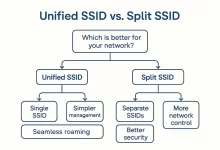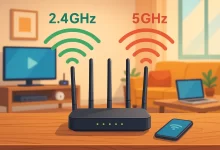
I still remember hauling a beige 802.11b PC-Card to a coffee shop in 2001—thrilled about “11 Mbps” while my dial-up friends stared in envy. Fast-forward to last month when I pushed 3 Gbps over WiFi 6E during a VR demo and nobody blinked. That dizzying leap is exactly why understanding WiFi Generations matters more than ever. WiFi Features & Core Fundamentals Every WiFi Generations release inherits three promises: untethered access, vendor interoperability, and backward compatibility. But the devil lives in PHY advances—modulation, coding, and antenna math that decide whether your Zoom stays crisp or crumbles. Wireless freedom via 2.4 GHz, 5 GHz, and now 6 GHz ISM bands. Plug-and-play scale—one SSID can host dozens of laptops, cameras, sensors. Standards governance...

Dual-band WiFi can feel like a magic carpet ride—or a rush-hour traffic jam—depending on one make-or-break choice: do you blend 2.4 GHz and 5 GHz under a single SSID or split them apart? As an IT outsourcing crew that lives or dies on service credits, we’ve watched too many clients face-plant because they copied the default wizard. This guide unpacks the nine fatal traps we keep bailing folks out of and hands you a battle-tested decision blueprint. Preface: The Coffee-Shop Myth Last winter I helped a boutique law firm troubleshoot “random WiFi freezes.” The junior admin swore unified SSIDs were best practice—because that’s how his home router shipped. Cute. Two hours and twenty Wi-Fi analyzers later we discovered every iPhone...

Dual-Band WiFi Setup: Should You Merge or Separate SSIDs? In today’s connected world, choosing the best dual-band WiFi setup can make a dramatic difference in performance, coverage, and stability. As more devices compete for bandwidth, deciding whether to merge your 2.4GHz and 5GHz bands under one SSID or keep them separate has become a hot topic among home users and tech enthusiasts alike. Understanding 2.4GHz vs 5GHz WiFi Bands Before diving into the pros and cons of a dual-band WiFi setup, it’s crucial to understand the key differences between 2.4GHz and 5GHz frequencies: Coverage Distance: 2.4GHz signals travel further and penetrate walls more effectively because of their lower frequency. This makes them ideal for larger homes or spaces with multiple...


 FoxDoo Technology
FoxDoo Technology FoxDoo Technology
FoxDoo Technology
